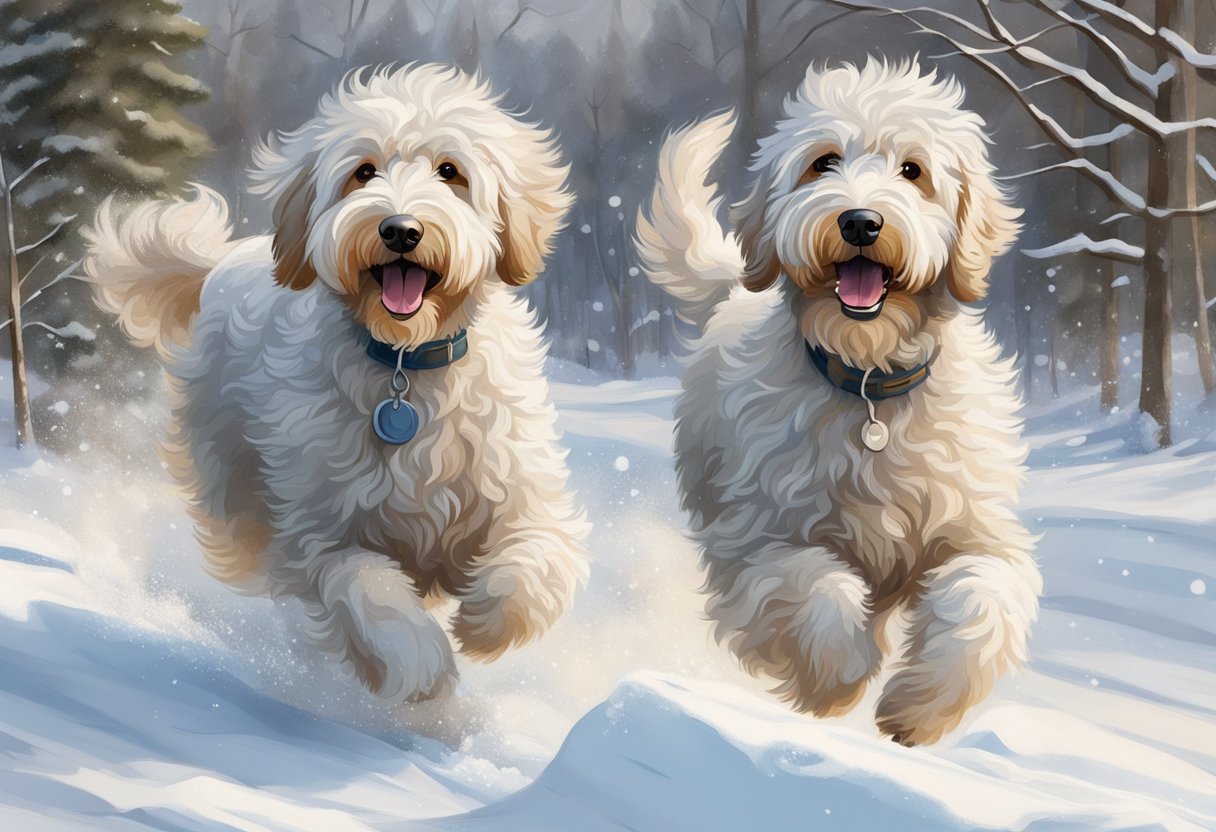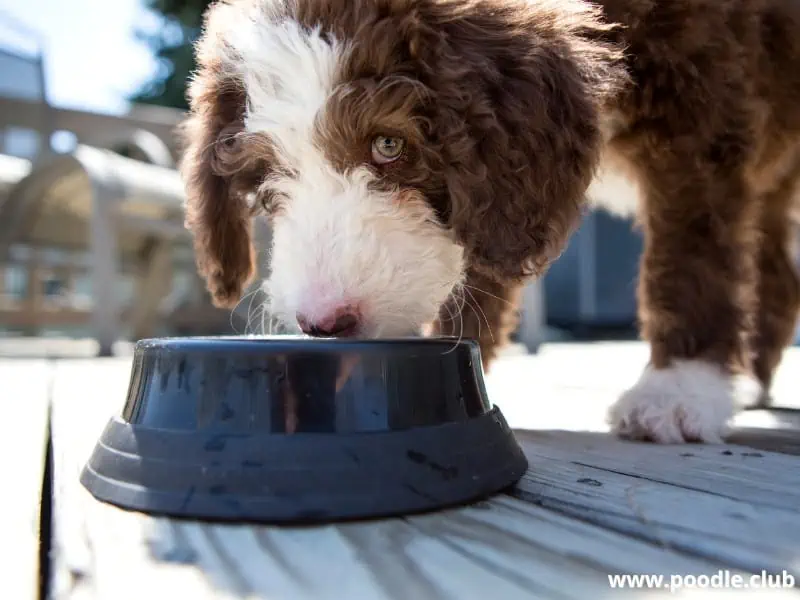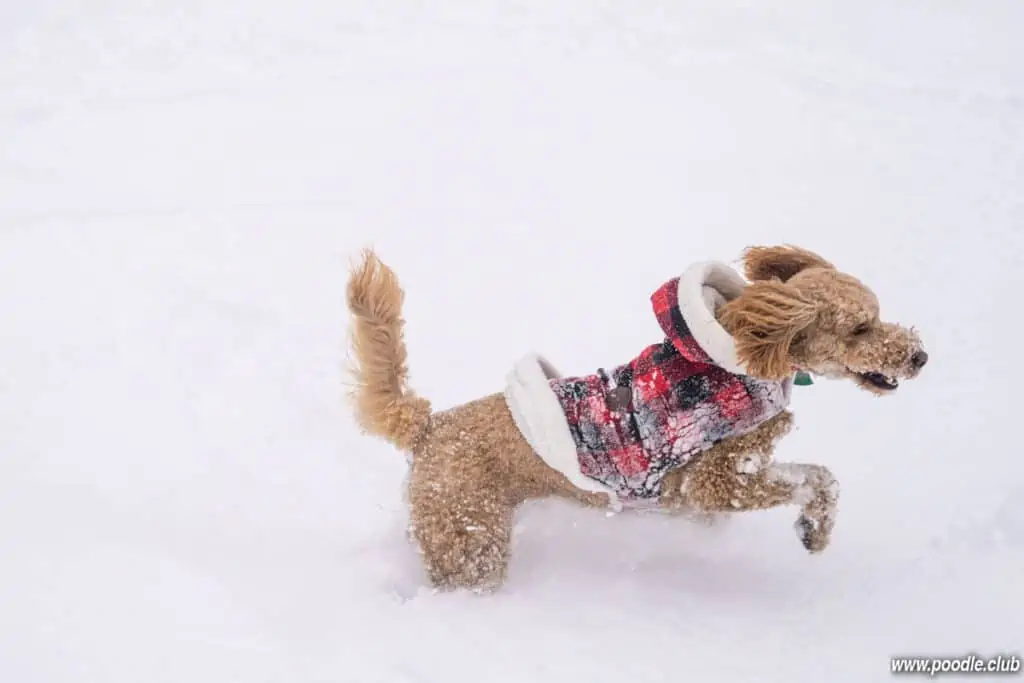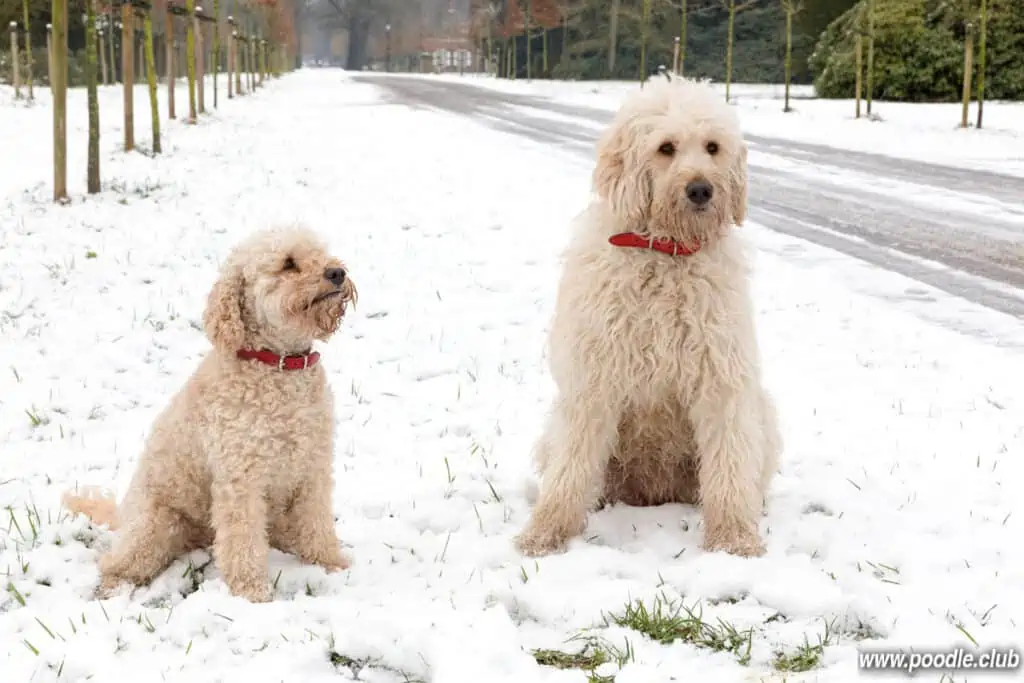Do Labradoodles Like Snow? A Definitive Answer for Pet Owners
As a Labradoodle owner, you might be wondering whether your furry friend enjoys the snow as much as you do.
Labradoodles are known for their friendly and playful personalities, which can make them quite adventurous in various weather conditions. While some Labradoodles relish frolicking in fresh snowfall, others may need time to adapt and adjust to the colder temperatures and new environment.
The reaction of your Labradoodle to snow largely depends on factors such as age, individual temperament, and prior exposure to cold weather conditions.
If your canine companion hasn’t experienced snow before, it’s essential to gradually introduce them to this weather scenario. While taking the time to adapt, some Labradoodles need extra care and grooming during winter months to ensure their health and comfort.

Key Takeaways
- Labradoodles have varying reactions to snow depending on factors like age and temperament.
- Gradual introduction and adaptation to cold weather is essential for some Labradoodles.
- Extra care and grooming are necessary during winter months for your dog’s comfort and safety.
Adaptation of Labradoodles to Snow
As a Labradoodle owner, you may wonder how well your furry companion can adapt to cold and snowy conditions. Understanding your Labradoodle’s cold tolerance is crucial in ensuring their safety during winter months.

Labradoodles are generally well-suited for snowy environments thanks to their thick, double-layered coats. The outer coat is long and wavy, providing water resistance, while the inner coat offers insulation to keep them warm in cold temperatures. This combination allows your Labradoodle to remain quite comfortable when playing or exploring in the snow.
However, it’s essential to remember that individual factors influence a Labradoodle’s cold tolerance. It can vary based on the dog’s age, health, and coat type. Younger and older dogs, as well as those with certain health issues, may be more susceptible to the cold.
Additionally, Labradoodles with fleece or hair coats might not have the same insulation as those with wool coats, so they might be more prone to shivering in chilly temperatures.
To ensure your Labradoodle’s comfort in snowy conditions, you can take some practical steps:
- Monitor their behavior: If your Labradoodle shows signs of discomfort or shivering, consider shortening their outdoor playtime or providing more significant protection from the elements.
- Provide appropriate clothing: A dog jacket or sweater can offer additional warmth for Labradoodles with thinner coats or those more sensitive to the cold.
- Keep them active: Encourage your Labradoodle to engage in physical activity when outdoors, as this helps generate body heat and maintain their overall comfort.
In conclusion, Labradoodles generally adapt well to snow and cold environments due to their coat characteristics. However, individual factors may influence their cold tolerance, making it essential to monitor their comfort levels and take appropriate action when necessary.
Necessity of Winter Care and Grooming
Labradoodles are known for their coats, which come in three main types: wool, fleece, and hair. Regardless of the type, proper care and grooming are essential during winter months.

Your Labradoodle’s coat is designed to provide warmth and protection from the elements. However, maintaining its effectiveness requires regular grooming. In winter, you’ll want to pay extra attention to keeping your dog’s coat healthy and well-maintained to ensure comfort and insulation.
PuppySpot is a reputable dog marketplace where you can browse and find compatible puppies right from the comfort of your home. They have placed over 200,000 puppies into homes in the US!
Coat care is especially necessary when it comes to Labradoodles with a fluffy coat, as their dense hair can easily become matted or tangled. To prevent these issues, ensure you brush their coat at least once a week using a slicker brush or a comb specifically designed for their hair type.
Both the wool and fleece coats are hypoallergenic, which means they are less likely to cause allergic reactions. However, this comes with a caveat: the dense undercoat common in these coat types can trap dirt and debris, possibly leading to skin irritation or infection. Regular, thorough brushing will help eliminate any trapped dirt and keep your dog’s skin healthy.
In addition to brushing, winter grooming should also involve trimming your Labradoodle’s hair, especially in areas prone to accumulating snow and ice, such as between their paw pads. Keep an eye out for any ice balls or snow clumps that might cause discomfort and promptly remove them.
Finally, remember that although your Labradoodle’s coat provides warmth, extreme cold can still be dangerous. Investing in protective gear, like a warm dog coat or sweater, can offer an additional layer of insulation on particularly frigid days. Make sure to dry your dog off after snowy adventures to avoid dampness, which can exacerbate the cold.
In summary, ensuring proper winter care and grooming for your Labradoodle is essential to keep them comfortable, warm, and protected. By maintaining their coat and taking appropriate precautions when venturing outdoors in the cold, you’ll help your furry friend enjoy a happy, healthy winter season.
Health Concerns and Signs to Watch Out for
As you enjoy the snowy weather with your Labradoodle, be mindful of potential health concerns and symptoms that might indicate a problem. Watch for hypothermia and frostbite, which can occur if your Labradoodle gets too cold.

Symptoms of hypothermia in dogs include:
- Shivering
- Whining
- Lethargy
- Slow or shallow breathing
- Loss of coordination or disorientation
To minimize the risk of hypothermia, ensure your Labradoodle is dressed appropriately, especially during prolonged exposure to cold temperatures.
Frostbite is another concern during snowy outings. It occurs when your dog’s extremities, such as ears, tail, or paws, freeze due to the cold. Signs of frostbite include:
- Cold, pale, or hard skin
- Swelling
- Discoloration of the affected area
- Pain when touched
If you suspect your Labradoodle may be experiencing hypothermia or frostbite, bring them indoors immediately and contact your veterinarian for advice.
Playing in the snow can be fun, but it can also aggravate existing conditions like osteoarthritis. This is because cold weather can cause joints to become stiff, and slipping on ice can lead to injuries. If your Labradoodle has osteoarthritis or joint issues, consider providing them with joint supplements or seeking advice from your veterinarian on how to support their mobility during cold weather.
In summary, when spending time in the snow with your Labradoodle, stay vigilant about their health and well-being. Observe them closely for any concerning signs or symptoms. Always consult with your veterinarian if you are unsure or have concerns about your dog’s health.
Feeding and Exercise Needs in Cold Weather
During cold weather, your Labradoodle’s energy needs may increase. Feeding your dog a bit more food can help them maintain a healthy weight, as they will burn extra calories to stay warm. It’s important to monitor your dog’s weight and adjust their food intake accordingly.

You may need to increase their daily portion by around 10%, but be cautious not to overfeed them.
In addition to their diet, don’t forget about exercise. Labradoodles are active dogs who need regular physical activity to stay healthy and happy. The cold weather shouldn’t be a deterrent for outdoor play.
In fact, many Labradoodles love snow! Just ensure that you’re providing your pup with appropriate protection from the cold such as a well-fitted coat and boots if necessary.
While enjoying the outdoors, consider introducing some winter-specific activities to your dog’s routine:
- Snowball fetch: Toss snowballs for your Labradoodle to catch and chase.
- Snow maze: Create a maze or trail in the snow for your dog to explore or follow.
- Hide and seek: Bury toys or treats in the snow for your dog to find and dig up.
Remember that in extreme cold, it’s important to be vigilant about your Labradoodle’s safety and well-being. Keep an eye out for signs of discomfort such as shivering, lifting paws, or trying to turn back towards home. Also, be sure to wipe your dog’s paws after a snowy walk to remove any ice, snow, or harmful chemicals they may have picked up.
By balancing your Labradoodle’s diet and exercise needs during cold weather, you can ensure that they stay healthy, happy, and ready to enjoy the snow.
Garments and Protective Measures
As a Labradoodle owner, it’s important to ensure your pet is protected against harsh winter conditions, especially when playing in the snow. Proper clothing and protection can keep your dog warm, comfortable, and safe.

Consider investing in a sweater or jacket designed specifically for dogs. These garments provide an additional layer of insulation against the cold and help retain your Labradoodle’s body heat. Look for high-quality materials that are both comfortable and durable.
Boots or booties are essential to protect your dog’s sensitive paws from snow and ice. They not only offer insulation but also shield the paws from harmful substances like salt and chemicals used to melt snow. Choose booties with a secure fit that won’t slip off during playtime.
Applying petroleum jelly to your Labradoodle’s paws can also serve as a protective barrier. It helps to prevent dryness, cracking, and irritation caused by prolonged exposure to snow and ice.
Don’t forget to keep a blanket nearby when outdoors. Your dog can sit or lie on it if they need a break from playing in the snow, reducing contact with the cold surface.
Here’s a quick list of items to consider for your Labradoodle’s snow protection:
- Sweater or jacket
- Boots or booties
- Petroleum jelly
- A warm blanket
With these protective measures in place, you can be confident that your Labradoodle will be better equipped to enjoy their snowy adventures while staying safe and warm.
Environmental Factors and Safety Precautions
When taking your Labradoodle out in the snow, it is important to be aware of the environmental factors and safety precautions to ensure a fun and safe experience for your pet. Snow and cold temperatures can present certain challenges that require your attention.

One crucial aspect to consider is the presence of water and ice. Snow can quickly turn into slippery ice, increasing the risk of injuries to your dog. To avoid this, choose a safe, well-trodden path and be cautious of the icy patches.
In addition, your Labradoodle’s fur can accumulate snowballs which eventually melt and cause discomfort. Gently remove these snowballs from its fur and periodically check its paws for accumulated ice.
De-icing chemicals and salt used to clear the snow can be toxic to your Labradoodle. These substances can irritate your dog’s paws or can be consumed as they lick their feet to clean them. To prevent this, use pet-safe alternatives for ice melt and thoroughly wipe their paws after a walk.
Consider using dog boots to protect their paws and avoid walking in areas with excessive use of de-icing products.
In cold temperatures, providing proper shelter and bedding can make a significant difference in your Labradoodle’s comfort. Always ensure they have a warm and dry place to rest inside your home. For outdoor situations, consider investing in a well-insulated dog house with waterproof roofing and elevated flooring, which will protect them from the cold ground.
While enjoying the snow, be mindful of the risks posed by antifreeze. This toxic substance can be lethal to dogs if ingested, even in small amounts. Many dogs are attracted to its sweet smell and taste, which makes it an even greater threat.
Make sure to store antifreeze containers out of reach and promptly clean spills to avoid an accidental ingestion.
Finally, keep a close eye on your Labradoodle for any signs of discomfort or cold. Shivering, lethargy, and whining can be indications that your dog is too cold and needs to be brought to a warmer environment. Labradoodles have a good amount of fur, but it’s crucial to monitor their well-being and make adjustments as needed.
By taking these environmental factors and safety precautions into account, you can ensure that your Labradoodle has an enjoyable and secure time in the snow.







![Why Do Poodles Shake? [5 Reasons]](https://poodle.club/wp-content/uploads/2022/12/why-do-poodles-shake-768x512.webp)